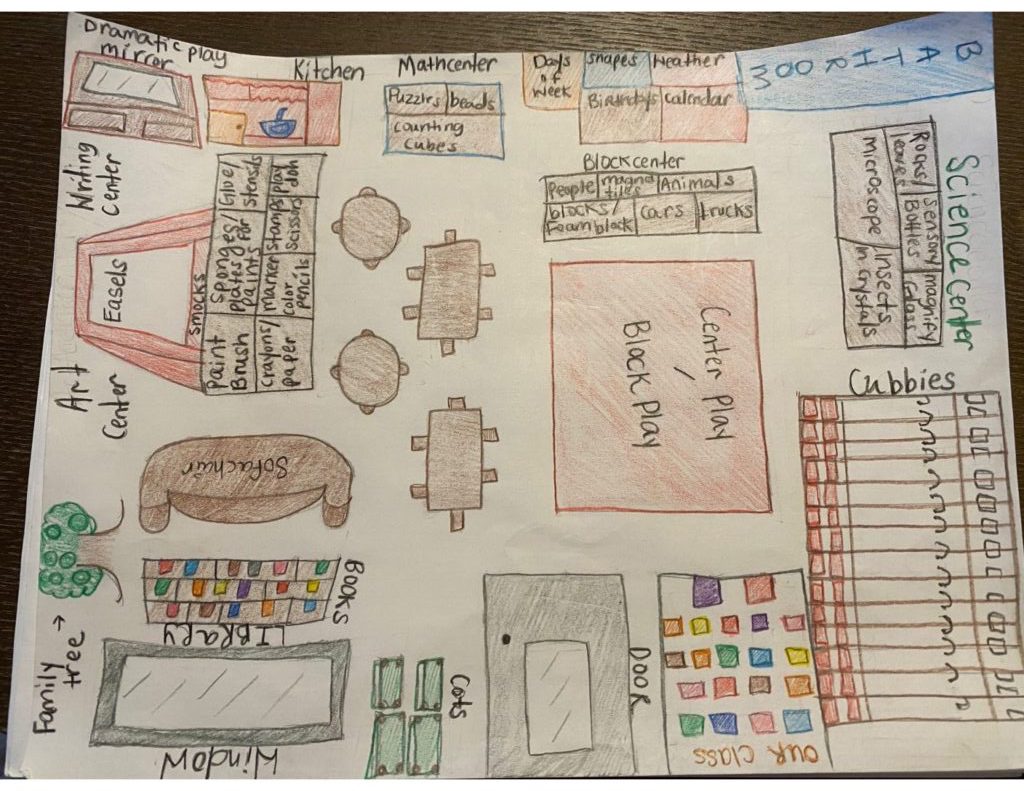Due Date: October 17
For this assignment you will create a developmentally appropriate early childhood classroom designed to support creativity. You will then write a reflective paper that explains your choices. There are three parts to this assignment:
- Classroom Layout/Map
- Materials List
- Reflection Paper
There are resource materials to use in creating your materials list and student examples of classroom maps included in the guidelines. Please read through the entire assignment carefully, and be sure that you complete all three parts.
1. Classroom Layout/Map
Your classroom layout should be designed to look professional, as it will be uploaded to your ePortfolio. It can be hand-drawn or designed on a computer using MS Word, MS Powerpoint, or an online classroom design app. If you choose to hand draw your classroom layout, please use design tools, such as a straight edge ruler, and pay attention to the dimensions of the room and of each center.
The classroom layout must be at least 8-1/2 x 11 inches (it can be larger) and must clearly indicate the purpose of each thematic center. Your layout should offer a birds-eye view of your classroom (that is, as seen from above).
Show the layout of furniture and a design that includes developmentally appropriate and creative learning centers. Account for different types of activities (quiet, noisy, messy), space needs, whole group/small group meeting areas, etc.
Assumptions:
- Your classroom is designed for 3-5 year olds.
- Your class will include 18 students and 2 teachers. Your students are racially, ethnically, and linguistically diverse.
- You have been given a reasonable budget to design and outfit the centers.
2. Materials List
On a separate sheet of paper, provide a complete and well-organized list of the types of materials, supplies and resources to be included in each thematic center. You may use the template to help you organize the list or you may choose your own format. Be detailed and specific in your list. Include a variety of materials. Remember to include furniture (e.g., chairs, tables, storage shelves) and flooring. Think about what you will need for the dramatic play center, the block center, the library/relaxing center. Think about what you will need for the art center for painting, drawing, collage, sculpting, etc. Where will children do art?
For ideas, review the supply catalogs in the list of Resource Materials included below. Be sure to select materials that support divergent learning experiences.
3. Reflective Response
Two (2) pages, double-spaced, 12-point font, standard margin settings. Use APA guidelines for citations.
Write a paper that responds to the following questions:
- How does your environment foster children’s creative expression and the arts?
- How do the materials you have provided offer opportunities for divergent learning?
- How do the centers you have chosen support young children’s development across various domains (cognitive, language/literacy, social/emotional, physical)?
- How is your classroom environment designed in a way that reflects developmentally and culturally appropriate practice?
Resource Materials
These resources will help you design your classroom and find appropriate furniture and materials for each learning center:
Steps to Designing Your Classroom
Research
- Recall classrooms that you have observed
- What did you like about the classroom layout?
- What would you change?
- Refer to the readings about learning environments and consider how the environment shapes learning
- How will your arrangement and materials teach your students?
- Gather ideas by searching online classroom layouts. Be critical!
- Which classrooms are well designed? Why?
- Which ones aren’t? Why not?
Plan:
- Brainstorm: What are some classroom “must-haves” for you (e.g., windows, a sink, a large space, a door to the school yard, a garden)?
- Draft a classroom design either using paper and pencil or working on your computer.
- Think about different kinds of table arrangements you can make for different purposes (small group work, snack, individual focused work, tables for art projects)
- Similarly, consider your shelving for storage, accessibility for students and arranged displays and activities students will learn from.
Finalize
- You can hand-draw, using drafting tools, or use a computer program (Word, Power Point, Google Slides, etc.) to make your layout.
- If you are unfamiliar to designing in this way, it will take practice before it becomes comfortable to use.
- For each of these programs, you click “Insert Shapes” and can select options to change colors of the outlines and fill.
- Depending on the program, you can type inside the shape or add text boxes to fill the shapes with text.
- Each center and area must be labeled.
- You do not need to list materials in the classroom layout/map. Attach a separate list.
Examples:
Below are a few student examples. None are perfect, but all have interesting concepts. Use these examples for inspiration, but find your own perfect classroom layout. What centers are important to you? What materials do you want to include in these centers?
Example 1
Classroom-Layout-3Example 2

Example 3

